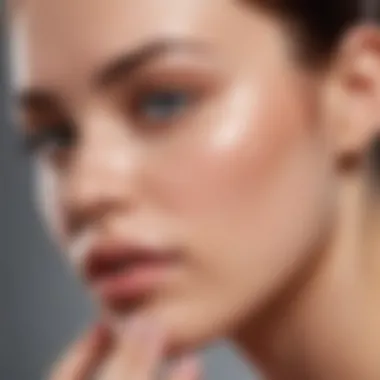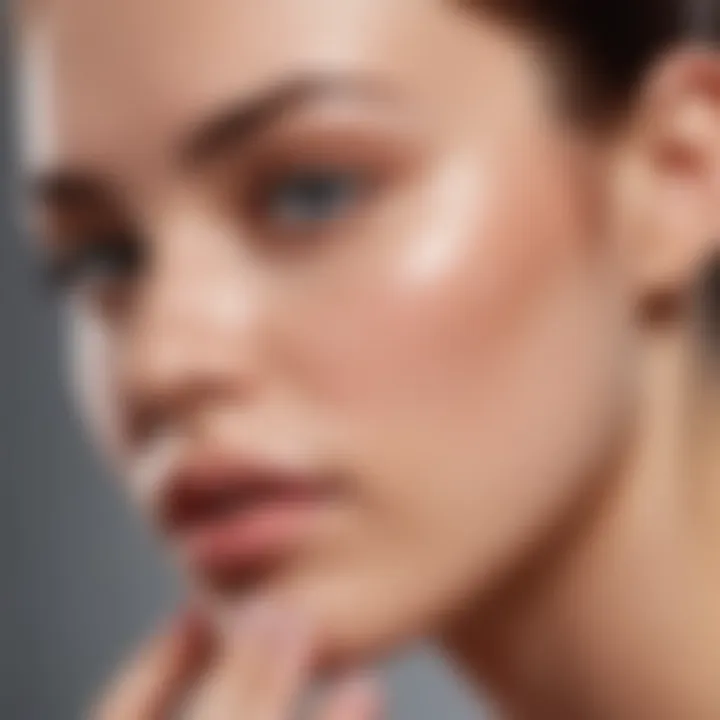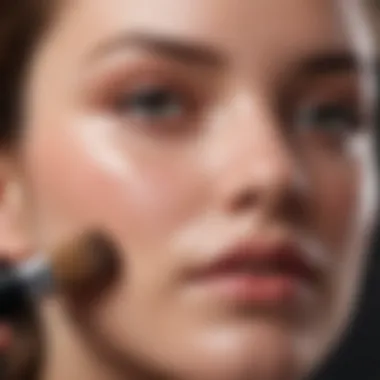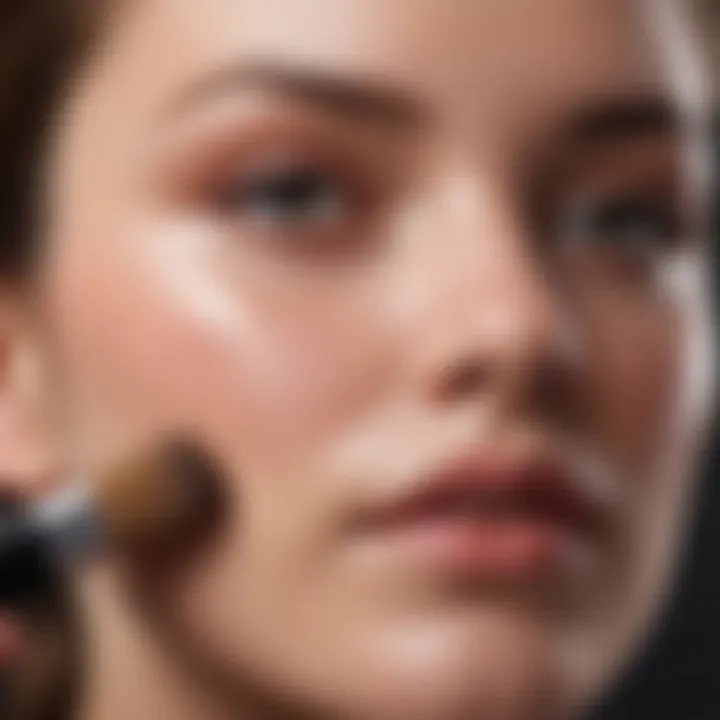Top Pore Minimizing Primers for Acne-Prone Skin


Intro
Acne-prone skin presents unique challenges. Pore size can become more pronounced due to acne and oiliness, leading many to seek effective solutions. One popular approach to address this issue is the use of pore minimizing primers. These specialized products not only help create a smooth base for makeup but also aim to reduce the appearance of pores. Understanding their formulation and function is crucial for anyone who struggles with acne.
In this article, we will examine some of the best pore minimizing primers tailored for acne-prone skin. We will explore essential ingredients that combat breakouts while ensuring a polished look. Furthermore, we will review specific products that have garnered positive feedback from users. Each product will be evaluated not only for its pore-minimizing capabilities but also for its compatibility with sensitive skin.
Additionally, effective application techniques will be discussed to maximize the benefits of primers. Special attention will be given to the daily skin routines that can enhance results. This comprehensive overview aims to inform and empower those dealing with acne-prone skin. Let's commence by looking into key aspects of using pore minimizing primers.
Understanding Acne Prone Skin
Understanding acne prone skin is fundamental to selecting the right pore minimizing primer. When dealing with makeup, it is crucial to know how specific skin characteristics influence product compatibility and performance. This section will elaborate on the defining features of acne-prone skin, the common causes behind breakouts, and how makeup interacts with this sensitive skin type.
Characteristics of Acne Prone Skin
Acne prone skin often displays specific features that set it apart from other skin types. Individuals may notice oiliness, enlarged pores, and frequent breakouts. Oily skin tends to produce excess sebum, which clogs pores leading to acne. Enlarged pores can also trap dirt and bacteria, contributing to inflammation and breakouts. Sensitive skin may react adversely to various products, which is why choosing the right primer becomes critical for maintaining skin health.
In addition, acne prone skin may also appear uneven, with visible post-acne marks or scars. These physical characteristics can affect the overall appearance, making it essential to use products that not only minimize pores but also address these concerns in a gentle manner.
Common Causes of Acne
Understanding the underlying causes of acne is essential for effective treatment and prevention. Several factors can contribute to breakouts:
- Hormonal fluctuations: Changes in hormone levels can trigger increased oil production, leading to acne.
- Dietary habits: Some studies suggest a link between diet, particularly high-glycemic foods, and acne severity.
- Stress: It is known that stress can lead to hormonal shifts, which may exacerbate acne.
- Improper skincare: Using comedogenic products can block pores, leading to further breakouts.
- Genetics: Family history plays a role in the likelihood of developing acne.
Awareness of these factors can help individuals make informed choices about the skincare products they use and the lifestyle changes they adopt.
How Makeup Affects Acne Prone Skin
Makeup can have both positive and negative effects on acne prone skin. On one hand, the right makeup products, particularly those designed for oily or acne prone skin, can enhance appearance and confidence. On the other hand, the use of comedogenic or heavy makeup can worsen the situation, causing further breakouts and irritation.
For individuals with acne prone skin, using lightweight, breathable makeup is recommended. Look for formulations labeled as non-comedogenic, which means they are less likely to clog pores. Additionally, selecting the appropriate primer can create a smoother canvas for makeup application while providing treatment benefits.
Importance of Primers for Makeup Application
Makeup application requires careful thought, especially for individuals with acne-prone skin. Primers play a critical role in how makeup sits on the skin, affecting its longevity and appearance. They prepare the skin for layers of makeup, ensuring a smooth and even canvas. This is particularly valuable for those with imperfections such as enlarged pores and blemishes.
Using a primer designed for acne-prone skin minimizes the visibility of pores and smooths out any rough texture. The result is a more flawless finish, which provides not just visual appeal but also boosts confidence.
What is a Primer?
A primer is a cosmetic product applied before foundation and other makeup. Primers can come in various forms such as creams, gels, or sprays. Their main purpose is to create a barrier between the skin and makeup. This helps in making the makeup last longer while also improving how it looks. For individuals with acne-prone skin, choosing the right primer ensures that it doesn’t clog pores, which could exacerbate skin issues.
Benefits of Using Primers


Using a primer has multiple advantages:
- Smooth Application: By filling in fine lines and imperfections, primers allow makeup to glide on more easily.
- Increased Longevity: Primers help makeup stand the test of time, reducing the need for frequent touch-ups throughout the day.
- Enhanced Finish: They can provide additional benefits, such as a matte effect or luminosity, based on the formula.
- Targeted Solutions: Specific primers can target oiliness or dehydration, tailoring the makeup experience to individual skin needs.
The Role of Primers in Skincare Regimens
Primers should be considered an integral part of a skincare routine, particularly for those concerned about acne. They not only enhance makeup application but also work in conjunction with other skincare products. When applied after moisturizer and before foundation, primers can assist in locking in hydration while preventing product migration that can lead to breakouts. Incorporating a well-formulated primer helps create a balanced makeup routine, ensuring that skin appears healthy under cosmetics.
"The right primer can transform your makeup application and skincare routine, improving the overall appearance of your skin while addressing concerns like acne."
Key Ingredients to Look For
When selecting a pore minimizing primer for acne-prone skin, the importance of key ingredients cannot be overstated. These ingredients can significantly impact how the product performs on your skin, influencing both its immediate effects and long-term benefits. The right components not only help in minimizing the appearance of pores but also contribute to improved skin texture, oil control, and moisture retention. Understanding these elements allows consumers to make informed decisions that will benefit their skin health and overall appearance.
Silicones for Smoothing
Silicones are a primary ingredient in many primers due to their smoothing properties. They create a light film on the skin that can fill in fine lines and pores. This helps create an even surface, preparing it for makeup application. Common silicones found in primers include dimethicone and cyclopentasiloxane. While these compounds aid in achieving a flawless finish, there is some debate over their long-term effects on acne-prone skin.
For many users, silicones can provide an immediate smoothing effect, essential for achieving a polished look. However, those with sensitive or very acne-prone skin should observe how their skin reacts. Overall, silicones can be beneficial for many, but they require individual assessment and caution in usage.
Non-comedogenic Formulations
Non-comedogenic products are formulated to avoid clogging pores. This is crucial for individuals with acne-prone skin, as clogged pores often lead to breakouts and exacerbation of existing acne. When choosing a primer, it is crucial to look for labels indicating non-comedogenic formulations.
Such formulations typically include lighter oils and minimal fillers, allowing skin to breathe while still providing the necessary smoothness and hold. Ingredients like water or glycerin are common in non-comedogenic products, ensuring hydration without added heaviness. In summary, opting for a non-comedogenic primer can be a significant step in managing acne while still enjoying makeup.
Active Ingredients for Acne Treatment
Salicylic Acid
Salicylic acid is widely regarded as an effective acne treatment ingredient. It is a beta hydroxy acid known for its ability to penetrate deep into the pores, helping to exfoliate and reduce inflammation. This characteristic makes it a popular choice for primers designed specifically for acne-prone skin. Its effectiveness in unclogging pores is a key reason it is included in many formulations.
Salicylic acid's unique feature is that it can also help to prevent future breakouts while smoothing the skin's texture. Thus, it offers a dual benefit: reducing acne and enhancing the overall look of the skin. However, caution should be exercised as overuse can lead to dryness and irritation.
Benzoyl Peroxide
Benzoyl peroxide is another potent acne-fighting ingredient. It works by introducing oxygen into the pores, killing acne-causing bacteria and reducing inflammation. This makes it a beneficial inclusion in formulations targeting acne-prone individuals.
One notable feature of benzoyl peroxide is its ability to provide rapid results in treating active breakouts. However, with its strength comes the potential downside, such as skin dryness or irritation for some users. As with salicylic acid, it should be used judiciously and cannot be overlooked in a proper skincare regimen.
Top Pore Minimizing Primers Reviews
The significance of pore minimizing primers cannot be overstated for those with acne-prone skin. These products serve as the unsung heroes of makeup application. They create a smooth canvas by filling in fine lines and pores, enhancing the overall finish of the makeup. This section will explore various priming products tailored for acne-prone skin, focusing on their specific characteristics and advantages.


Product One: Description and Benefits
The first product worth discussing is the Smashbox Photo Finish Pore Minimizing Primer. This primer is particularly favored for its oil-free formulation. It includes a blend of silicones that effectively blurr imperfections while controlling shine throughout the day. The non-comedogenic properties make it suitable for acne-prone skin. Moreover, the matte finish achieved after application provides a perfect base for makeup, making it a reliable option for those struggling with oily skin.
Product Two: Description and Benefits
Next, we have the Benefit POREfessional Face Primer. This product has a cult following among makeup enthusiasts. It not only minimizes the appearance of pores but also helps to soften the skin's texture. It accomplishes this through its silky formula that absorbs quickly. One unique aspect of this primer is its extract of chamomile, which has soothing properties, aiding sensitive skin that may often accompany acne issues. Users appreciate that it can be applied alone or under makeup, making it versatile.
Product Three: Description and Benefits
The Tatcha The Silk Canvas is another noteworthy candidate. This primer goes beyond standard pore-minimizing. It merges skincare benefits with makeup application. Formulated with a blend of silk proteins, the primer protects skin from pollutants and makes makeup last longer. It is also enriched with various antioxidants that assist with skin repair. Furthermore, it is suitable for a range of skin types, providing hydration without clogging pores. Users commend its ability to create a luminous yet smooth finish, striking a balance that many products fail to achieve.
Comparative Analysis of Selected Primers
When weighing these products, several criteria emerge as essential for effective selection. First, consider the formulation; primers that are silicone-based often provide a smoother finish, whereas those with active skincare ingredients can promote skin health over time. The use of non-comedogenic claims should guide choices to prevent exacerbating skin irritation.
Here’s a quick comparison:
| Product Name | Key Feature | Suitable Skin Type | Key Ingredient | | Smashbox Photo Finish | Oil-free, blurs imperfections | Oily, acne-prone | Silicones | | Benefit POREfessional | Soothing, versatile application | Sensitive, oily | Chamomile extract | | Tatcha The Silk Canvas | Skincare benefits, antioxidant-rich | Dry, combination | Silk proteins |
When selecting a primer, consider your unique skin needs and preferences. This helps to maximize both the appearance and health of your skin.
Overall, these three primers cater to different aspects of pore minimization and makeup longevity while being mindful of the unique challenges faced by acne-prone skin. Their distinctive features and benefits can help guide users in making informed decisions tailored to their specific requirements.
How to Properly Apply Primer
Understanding how to apply primer is crucial for those with acne-prone skin. The right application technique not only enhances the effectiveness of the primer but also impacts the overall appearance of makeup. Proper application can lead to a smoother finish, increased longevity of makeup, and a reduction in clogged pores, which is beneficial for sensitive skin types. Here, we detail the steps to ensure that each application maximizes the potential of pore minimizing primers.
Pre-Application Steps
Before applying a primer, it is important to prepare the skin effectively. This preparation sets the basis for a flawless makeup outcome.
- Cleansing: Start with a suitable facial cleanser. It removes impurities and excess oil without aggravating the skin.
- Toning: Use a toner that does not contain alcohol. This helps balance the skin’s pH and tightens pores.
- Moisturizing: A lightweight, non-comedogenic moisturizer is essential. This helps hydrate the skin without causing breakouts.
- SPF Protection: If a primer does not include sun protection, apply a broad-spectrum sunscreen. This is vital for protecting acne-prone skin from UV damage.
Each of these steps contributes to creating a smooth canvas, reducing the risk of irritation or oily patches throughout the day.
Application Techniques
The technique of applying primer can significantly influence its performance. Here are some effective methods to consider:
- Use Clean Hands or Tools: Apply with your fingertip or a makeup sponge. Clean tools prevent bacteria from transferring to the skin.
- Dabbing Motion: Instead of rubbing, dab the product onto the skin. This technique helps push the primer into the pores, enhancing its effectiveness.
- Focus on Problem Areas: Apply a slightly thicker layer on areas prone to larger pores and oiliness, such as the T-zone.
- Allow It Time to Set: Let the primer sit for a few minutes before applying foundation. This waiting period is crucial for the primer to bond with the skin.
Post-Application Tips


After the primer is applied, certain aftercare can further improve makeup longevity. Consider these tips:
- Check for Shine: If the skin appears oily after primer application, lightly dust a translucent powder over those areas.
- Smooth Foundation Application: When applying foundation on top of primer, use a technique that complements the primer’s properties for the best results.
- Evaluate Skin Throughout the Day: Monitor how the skin reacts. If breakouts occur, review the product ingredients and discontinue use if necessary.
Keeping these post-application tips in mind can help you manage and adapt your makeup routine effectively.
Common Mistakes to Avoid
Understanding the common mistakes people make when selecting and applying pore minimizing primers is critical for ensuring that the final makeup look meets expectations. By avoiding these pitfalls, individuals with acne-prone skin can enhance their overall appearance and health of their skin. This section will highlight three significant mistakes that can hinder skin appearance and acne management.
Choosing the Wrong Formulation
Selecting an ill-suited primer can have noticeable consequences for acne-prone skin. Primers with heavy silicones may initially create a smooth surface, but they can also trap oils and bacteria, leading to breakouts. Some formulations might include irritating ingredients such as fragrances or alcohol, which can exacerbate sensitivity and redness. To minimize the risk of adverse reactions, it is essential to look for non-comedogenic products. This means that the formulation should not clog pores. A thorough ingredient list review helps in identifying potential allergens. Using a primer specifically designed for oil control can also make a considerable difference. Making informed choices will result in better makeup longevity and improved skin health.
Over-Applying Primer
Another frequent error is applying too much primer. While the goal is to create a flawless base, over-application can lead to a heavy, cakey appearance. This mistake can also make it challenging for foundation to adhere evenly, resulting in uneven texture. A small amount is often sufficient to cover the necessary areas. The ideal application involves dotting the primer on the key areas and blending it out gently with fingers or a brush. By using only the amount needed, you not only avoid wasting product but also enhance the makeup's visual appeal.
Neglecting Skin Care Before Application
Before applying any makeup, proper skin care is vital. Skipping essential pre-application steps could undermine the effectiveness of the primer. Cleansing the skin to remove oil and dirt opens up pores and creates a clean canvas. Additionally, moisturizing is essential, even for oily skin types. Using a lightweight, non-comedogenic moisturizer helps keep skin hydrated without adding extra grease. Finally, applying sunscreen is a crucial step in a daily routine. This combination prepares the skin effectively, allowing the primer to perform better and ultimately improving the makeup's finish.
By paying attention to these common mistakes, women can significantly enhance their makeup routine and skin health. Remember that effective application and careful selection of products lead to a more refined appearance.
The Future of Pore Minimizing Primers
The inception of pore minimizing primers has significantly altered the makeup landscape, especially for those with acne-prone skin. As consumers become more informed and discerning, the demand for effective solutions grows. The future of pore minimizing primers will be crucial not just for aesthetic enhancement, but for addressing underlying skin concerns. Innovations are on the horizon, guiding the design of products that seamlessly merge skincare with makeup.
Innovations in Primer Formulations
Innovation in primer formulations is emerging rapidly. Companies are now focusing on creating products that not only serve as makeup bases but also nourish the skin. Advanced technology allows the integration of skin-benefiting ingredients like niacinamide and hyaluronic acid. These compounds offer hydration and support the skin barrier while minimizing the appearance of pores. The race towards achieving a flawless complexion continues to push brands to explore environmentally sustainable and skin-compatible ingredients.
- Bioengineered components: These are being developed to adapt to individual skin needs, aiming to address unique concerns, especially for sensitive or acne-prone skin.
- Smart technology: Some brands are pioneering primers that adjust to skin conditions in real-time, ensuring optimal results based on humidity or hormonal changes.
Emerging Trends in Skin Care
Modern skincare trends are increasingly leaning towards multi-functional products. Consumers are showing a preference for items that fulfill more than one role. This shift indicates a holistic approach to beauty and skincare, acknowledging that skin health is paramount. Therefore, primers are evolving beyond their traditional purpose.
- Transparency in ingredients: Shoppers are more aware than ever regarding what they apply on their skin. The demand for clean, transparent formulations is steering brands to disclose all ingredients clearly.
- Inclusive products: The beauty industry is adapting to create formulas that can cater to a wider array of skin tones and types, ensuring that everyone finds suitable products for their unique needs.
The Intersection of Makeup and Skincare
The boundaries between makeup and skincare continue to blur. The modern consumer is not just looking for coverage but is also invested in the well-being of their skin. This intersection has led to the birth of more sophisticated products aimed at providing both cosmetic benefits and skincare solutions. Primers are at the forefront of this movement.
- Skincare-infused primers: A noticeable trend is the emergence of primers that incorporate active ingredients traditionally found in serums. This change supports acne treatment while offering a smoother canvas for makeup application.
- Long-wear formulas: Enhanced durability often comes hand-in-hand with improved skin benefits, allowing wearers to maintain their look without compromising on skin health.
As consumers evolve in their understanding of beauty and skincare, brands will need to adapt to remain relevant, focusing on the health of the skin as much as the appearance.
Looking ahead, the future of pore minimizing primers holds immense potential. Innovators in the cosmetic industry must continue to prioritize efficacy and health, ensuring that products align with the modern consumer's ethics and needs. Embracing these changes will provide a pathway for enhanced beauty solutions that resonate with individuals experiencing acne-prone skin.







